#romanticera
Text
Now we've added early 19th century Lestat, since that's my personal favorite time period heheheheh 🦇
I am gonna color him and glamrock Lestat ofc but i have one more I'm gonna do...

#historic fashion#lestat de lioncourt#louis and lestat#interview with the vampire#romanticism#vintage#fashion history#victorian era#romanticera#lestat#rockstar lestat#lestat fanart#the vampire lestat#the vampire chronicles
9 notes
·
View notes
Text
Alexander Scriabine Concerto For Piano And Orchestra (1951)
Publication date 1951 PAUL BADURA-SKODA, Piano VIENNA SYMPHONY ORCHESTRA conducted by HENRY SWOBODA Alexander Scriabin, a key figure of the Russian Symbolist movement in music, has left behind a wealth of compositions that continue to enthrall listeners with their complexity and ingenuity. One such noteworthy composition is his Concerto for Piano and Orchestra in F sharp minor, Op. 20. This piece stands as a testament to Scriabin's unique harmonic language and his ability to create a profound emotional impact through music. Composed in the summer of 1896, when Scriabin was just 24 years old, the Concerto for Piano and Orchestra is a work of great depth and intricacy. It is a three-movement composition, each movement showcasing a different facet of Scriabin's compositional prowess. The first movement, marked "Allegro," begins with a dramatic and lyrical theme introduced by the piano, which is then echoed by the orchestra. This theme, full of chromaticism and rich harmonies, sets the tone for the rest of the movement. The interplay between the piano and orchestra is skillfully handled, with the piano often engaging in virtuosic passages while the orchestra provides a lush harmonic backdrop. The second movement, "Andante," is a slower, more introspective piece. The piano introduces a hauntingly beautiful melody, which is later developed by the orchestra. This movement is characterized by its dreamy, almost ethereal quality, showcasing Scriabin's ability to evoke a wide range of emotions through his music. The final movement, "Allegro moderato," is a lively and rhythmically complex piece. The piano and orchestra engage in a vigorous dialogue, with the piano often taking the lead with rapid, virtuosic passages. The movement concludes with a triumphant restatement of the main theme, bringing the concerto to a satisfying close. Scriabin's Concerto for Piano and Orchestra is a brilliant demonstration of his unique compositional style. The work is characterized by its complex harmonic language, virtuosic piano writing, and the masterful interplay between the soloist and orchestra. Furthermore, the emotional depth and intensity of the music make it a captivating listening experience. In conclusion, Alexander Scriabin's Concerto for Piano and Orchestra in F sharp minor stands as a significant contribution to the piano concerto repertoire. With its complex harmonies, lyrical themes, and profound emotional depth, it offers a glimpse into the mind of one of the most innovative composers of the late Romantic era.
#AlexanderScriabin#ConcertoForPianoAndOrchestra#ClassicalMusic#RomanticEra#RussianComposers#OrchestralWorks#MusicalComposition#MusicAnalysis#PianoConcertos#MusicAppreciation
0 notes
Text

It’s easiest to learn surrounded by beauty <3
0 notes
Text
new update~
6 notes
·
View notes
Text
Bram Stokers Dracula (1992)
I have so many thoughts on this movie. I loved the set design, the costuming, the acting! It was all amazing. And I love about half of the movie- and....was lukewarm on the other half.
I love Dracula. My favourite rendition is still a theater adaption I saw years ago from a very well known Canadian theater.
I, however, don't love certain tropes that always seem to come along with vampires...like undying, soul-bound love. I've never liked soulmate tropes.
Which is why Bram Stokers Dracula was...almost disappointing for me at times. I was enjoying so much of the movie. I thought our time in Dracula's castle was perfect- foreboding and weird and creepy! I thought the performances were wonderful! I didn't love the reframing of Dracula's past (note: I don't mind giving Dracula a history but I feel like making him Vlad the Impaler from history, is just...a weak choice? Dracula has never felt like the right story to do historical fiction in.). I could've honestly loved the movie if Dracula's history was the only change that bothered me.
No, I hated the soul mate trope between Dracula and Mina.
Dracula seducing Mina is somewhat of a common thing I've seen in different adaptations. Some adaptations take out Lucy, and put her role on Mina to some degree. I'm not unused to the idea of Dracula seducing Mina, and I think it *can* be used effectively.
The movie did do that- but then it also decided that actually, Dracula is deeply in love with Mina...and it really feels like, to me, that Mina is in love with him. You can debate that the two weren't soulmates in this movie, but I still hate the romance between Mina and Dracula in this. I think it's the narrative change, to some degree. I love a romanticera vampire , and I love seductive vampires. I love vampires of all types. But this movie had a romantic Era style vampire, or really, more of a heavily gothic one, and then....it suddenly became an actual romance story between that vampire and a human woman. It just felt like a tonal whiplash to me.
I'm aware this honestly might just be me. I know this movie is widely popular and beloved by tons of Dracula fans! I'm just....not one of them.
1 note
·
View note
Text
Haikyuu!! Drabble Collection
Read this masterpiece on AO3 at https://ift.tt/S4pPMjk
by RomanticEra
1. Singles Inferno AU: Kiyoko meets a grumpy guy on Hell Island (tanakiyo, tskym - fluff)
2. Mid-Timeskip: Hinata gets lonely in Rio (kghn - fluff)
3. Post-Timeskip: Oikawa thinks of what could have been (oihina - light angst)
4. Post-Canon: Iwaizumi dreads a future with a man he can't bring himself to leave (iwaoi - angst)
5. Royalty AU: Prince Tobio is arranged to be married but already has somebody in his heart (kghn - hopeful ending)
6. Vaguely Canon Compliant: Daichi is Tetsurou's second choice (kurodai, kuroken - angst)
7. Canon Compliant: Keiji drowns in his sorrows while Bokuto moves on (bkak - angst)
8. NSFW!! Canon Compliant: Kei helps Tadashi relieve stress after a long day (tskym - loving smut)
9. NSFW!! Canon Compliant: Tadashi returns the favor (tskym - fluff and smut)
10. MCD!! Canon Divergent: Akiteru, Kei, and a car crash (angst, sad ending)
Words: 5944, Chapters: 10/?, Language: English
Series: Part 5 of Lin's Twitter Fics
Fandoms: Haikyuu!!
Rating: Explicit
Warnings: Creator Chose Not To Use Archive Warnings
Categories: F/F, F/M, Gen, M/M
Characters: Shimizu Kiyoko, Tsukishima Kei, Tanaka Ryuunosuke, Yamaguchi Tadashi, Hinata Shouyou, Kageyama Tobio, Oikawa Tooru, Iwaizumi Hajime, Bokuto Koutarou, Akaashi Keiji, Tsukishima Akiteru
Relationships: Shimizu Kiyoko/Tanaka Ryuunosuke, Tsukishima Kei/Yamaguchi Tadashi, Hinata Shouyou/Kageyama Tobio, Hinata Shouyou/Oikawa Tooru, Iwaizumi Hajime/Oikawa Tooru, Akaashi Keiji/Bokuto Koutarou, Tsukishima Akiteru & Tsukishima Kei
Additional Tags: One Shot Collection, singles inferno au, Alternate Universe - Reality Show, Getting Together, Canon Compliant, Brazil Arc, Angst, Ambiguous/Open Ending, Falling Out of Love, Alternate Universe - Royalty, Forbidden Love, unhealthy relationship, Post-Break Up, Sad Ending, Fluff and Smut, Established Relationship, Switching, Unprotected Sex, Hair Pulling, Light Dirty Talk, pillow princess, vehicular manslaughter
read it on AO3 at https://ift.tt/S4pPMjk
5 notes
·
View notes
Text
♡Candles♡Lighter♡Classicmusic♡Piano♡Violins♡Moon♡StarryNights♡Coffee♡Chai♡CollectedPoems♡VictorianLetters♡DirtySpecs♡SmellofBooks♡Brown♡Soltitude♡Autumn♡Cafes♡Bookstores♡Libraries♡Architectures♡Sculptures♡Fountainpens♡Literature♡Museums♡Louvre♡Pressedflowers♡OscarWilde♡SylviaPlath♡FranzKafka♡VirginiaWoolf♡HarukiMurakami♡Latin♡Greece♡Calligraphy♡Loafers♡LongCoats♡OldSweaters♡Death♡Oxford♡Renaissance♡Classicism♡GreekMythology♡RomanCulture♡CultOfDionysus♡RomanticEra♡TheSecretHistory♡TheCreationOfAdam♡Typewriters♡DeadPoetsSociety♡LeatherCovers♡
#literature#aesthetic#poetscommunity#poets corner#spilled ink#coffee#academia vibes#museums#cafes#books & libraries#reading#romanticize#classical music#greece#latin#dark academia#tumblr#tumblrgirl#dead poets society#classic literature#dark acadamia#tumblr aesthetic#spilled poetry#quote#romantic academia#chaotic academia#light academia
1 note
·
View note
Text

Reposted from @brooklynconservatory This Friday, September 23rd at St Ann and the Holy Trinity, come hear a concert by the Brooklyn Conservatory Chorale, our dynamic community choir.
The Chorale will be performing gorgeous works from the Romantic Era! The concert will also feature art song selections performed by professional vocalists within the ensemble. For tickets, go to https://buff.ly/3POeS2L
#bkcm #chorus #choir #romanticera #music #free #concert #brooklyn #bkconservatory @parkslopeliving @parkslopepatch
0 notes
Photo

Our c. 1835 Ada looks superb in Dusty Rose brocade! #periodcorsetscatalog #1830sfashion #1830s #historicalcorset #historicalcorsetry #historicalfashion #historicalcostuming #brocadecorset #brocadestays #historicalstays #bridgertoncorset #regencyfashion #regencystays #romanticera #romanticerafashion (at Seattle, Washington) https://www.instagram.com/p/Ca0QuEWvFpZ/?utm_medium=tumblr
#periodcorsetscatalog#1830sfashion#1830s#historicalcorset#historicalcorsetry#historicalfashion#historicalcostuming#brocadecorset#brocadestays#historicalstays#bridgertoncorset#regencyfashion#regencystays#romanticera#romanticerafashion
7 notes
·
View notes
Text
Chopin is a legend


2 notes
·
View notes
Text
The Romantic Era and the Rise of Sexism and Misogyny in Ballet
A note on this work in progress:
I was trained in the Vaganova method with Russian instructors, so I am biased in my passionate appreciation for Romantic Era ballet and Russian ballet in general. However, as a feminist researcher it is crucial that I still challenge my heroes and the internalized desire to be a tragic pretty princess.
Project Description and Annotated Biography:
The “prima ballerina”: an iconic title that conjures up images of a classic form of femininity—graceful, demure, witty, eye-catchingly chic. She is an unattainable sovereign, never seen publicly sweating or breathing heavily after exerting an Olympian level of energy. She puts out maximum effort with minimal disturbance to her audience. A cringeworthy description for most feminists, the archetype of a ballerina symbolizes what many would consider an outdated version of an ideal feminine. In my previous research on the evolution of ballet in a Russian and Soviet context, I have found many areas in this artistic medium where the culture has not quite caught up with twenty-first century ideals; perhaps not even the twentieth century.
For this project, I was curious about where this version of femininity began in ballet. The Romantic Era in Europe took place from the end of the eighteenth century through the mid-nineteenth century. This movement in art and literature was considered a response to the Enlightenment, an intellectual and philosophical movement that favored reason, logic, and the scientific approach to understanding humans and the natural world. Romanticism resisted this by encouraging works that embraced intense emotions, imagination, mysticism and creativity. It also served as an escape from the hardships of modernization due to industrialization.[1] For the ballet world, this ushered in a period that favored dramatic storytelling of love and heartbreak, with elaborate costumes and sets that would transport the audience to another realm. This period also birthed some of the most famous ballets in the classical canon, such as Giselle, Swan Lake, and La Sylphide. Each of these stories revolves around a woman’s theatricalized sacrifice, and always includes a moment at which the realistic portion of the story turns to surrealistic, whether through madness, sorcery, or death.[2]
Dance scholars believe that it was the Romantic Era that established the feminine character of the ballerina as we know her today.[3] In each these stories, the female protagonist was written to be at the whim of her deep emotions, often naïve and submissive to the male characters. While the star of the show was always the ballerina, it was men who were the company directors and choreographers, placing women in the position of subordinate both on and offstage. The primary and secondary sources I’ve compiled to support this patriarchal feminine standard in romantic ballet approach the topic from a few different angles. First, I collected a series of images from Giselle, Swan Lake and La Sylphide to show the similarities between them all, showcasing an almost stock supply of physical and choreographic frailty. All three ballets feature the ballerina in a virginal white costume that presents her as both pure and otherworldly. Next, I situated these ballets in their cultural origins, which would allow me to better understand the gender norms of the time. I have included below the original work of German poet Heinrich Heine, whose poetry and knowledge of Slavic folklore inspired the creation of Giselle. I also included the writings of early feminist Mary Wollstonecraft so that I could gain insight to women’s roles and consciousness around their oppression at the time. Lastly, I included contemporary scholarly work and the autobiography of a current New York City Ballet soloist to demonstrate how Romantic Era sexism and misogyny have continued to reproduce themselves through today.
Bibliography
Ballet, Bolshoi. Year and Date Unknown. La Sylphide.

Photograph of the Sylph and her lover, James, from La Sylphide. James has left his bride on their wedding day to pursue his obsession with the Sylph, who has been appearing at his window, tempting him to come live with her in the forest. Once he's arrived, she showers him with affection and delicious treats, and shortly thereafter disappears. Frustrated with her elusiveness, he falls for a witch's deceitful proposal to catch the Sylph permanently. The witch hands him a scarf that she has poisoned and tells him that he can use this to trap the Sylph forever. When the Sylph returns, James chases and catches her with the scarf, which instantly kills her. We see in the pose in this photo how delicate the ballerina is, with outstretched wiry arms that are a signature of Romantic Era ballerinas. This pose between partners emphasizes man's intense desire to own that which he can't have, and the woman's powerlessness against it. It also perpetuates the idea of women being irrational, flighty, and fragile.
Chalon, Alfred Edward. 1832. Marie Taglioni (1804-84) as the Sylph in 'La Sylphide'.
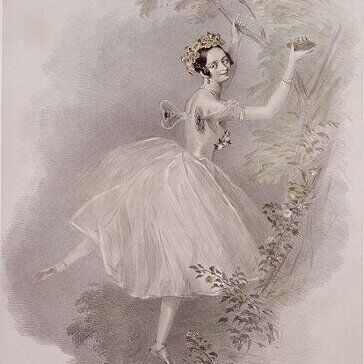
Illustration of Marie Taglioni as the Sylph from La Sylphide. Taglioni was the first ballerina to ever dance in point shoes; an aesthetic that both elongated the dancers' legs and allowed for a more ethereal style. In this photo, Taglioni holds a coy, delicate stance, with her feet notably shrunken-- a modification standard in the feminization of a woman. In this ballet, the character of the Sylph (fairy) lures a man away from his human fiancée with promises of a beautiful new life in the forest. Tricked by sorcery as a result of the fiancée’s jealousy, the Sylph dies from poisoning in the end. In my opinion, this character was an original "Manic Pixie Dreamgirl" (term coined by film critic Nathan Rabin in 2007), a modern misogynist movie trope wherein a whimsical woman with childlike traits is tasked with seducing a boring man, making herself responsible for his sexual/mental/emotional awakening until something tragic tears them apart.
Daly, Ann. 1987. "The Balanchine Woman: Of Hummingbirds and Channel Swimmers." The Drama Review: TDR , Vol. 31, No. 1 8-21.
In this article, Ann Daly challenges the widely held belief that choreographer George Balanchine glorified women. She includes quotes from him that share his philosophy on a woman's natural inferiority to a man's physical strength, resigning her to a position of acceptance and passivity. Balanchine believed that the ballet was the one place in society where women came first, and he claimed to make it his life's mission to dedicate his work to them. As the article continues and we read more quotes by the choreographer, a critical feminist scholar will likely see this stance as less of an honor, but rather a plain display of misogyny through objectification. What critics have called "manipulation" of the female dancer in a pas de deux, Balanchine sympathizers call "support": supporting the woman to be more powerful and beautiful than she could possibly be on her own. Daly explores the history of this brand of femininity in ballet, going back to the Romantic Era. She then asks readers to consider whether his ballerina is actually the star, or if she's on display, artistically preserving American toxic masculinity where men are active and therefor valuable, and women are passive objects of beauty.
Garafola, Lynn. 1997. Rethinking the Sylph: New Perspectives on the Romantic Ballet. Middletown: Wesleyan University Press.
In this compilation of essays, dance historian Lynn Garafola dissects the complexity of the Romantic Era of ballet, focusing largely on gender roles and nationalism. She describes this time period of ballet as an international movement, with its capitals in Paris and London. Innovations in technology allowed for easier sharing of creative ideas, and the invention of lithography allowed relatively inexpensive copies of ballet prints to be distributed internationally. French prints were the most popular, and their main subject was the ballerina. This was when the ballerina became an object of desire and mystery, symbolizing an otherworldly, unattainable woman. Her poise and airy costuming set her in a fantasy realm on the edges of European civilization, charming the viewer with either her chaste or exotic nature. I selected this source because I find the construction of the ballerina as the objectified yet unattainable "other" who embodied feminine ideals at the time very clever. The ability to possess her image made her seem accessible, but to see her at the theater in a setting whimsically foreign established an uninterrupted fantasy for those who sought her out. This tension plays into men's conditioned need to compete with himself and other men to prove himself worthy of acquiring the unattainable, while avoiding the discomfort of actual risk.
Heine, Heinrich. 1833. Deutschland: A Winter's Tale. Hamburg: Hoffmann und Campe .
This book by Heinrich Heine inspired the creation of Giselle, one of the most famous romantic ballets that is still a staple in today's companies' repertoires. In it he shares the Slavic folklore of Wilis: ghosts of women who have died from heartbreak before their wedding day. In his poem he describes these tragic specters as having “dead feet, there still remains that passion for dancing which they could not satisfy during life”. If a man wandered into their realm, they would seek their revenge by making him dance until he died from exhaustion. This poem hit several points for qualities desired in a romantic ballet-- madness, tragedy, heartbreak, ethereal scenes danced by ballerinas who seemed to transcend the limits of the human body, and the centering of women around their relationships with men.
Kenton, Tristram. 2018. "Vadim Muntagirov and Marianela Nunez." The Guardian. Swan Lake. London.
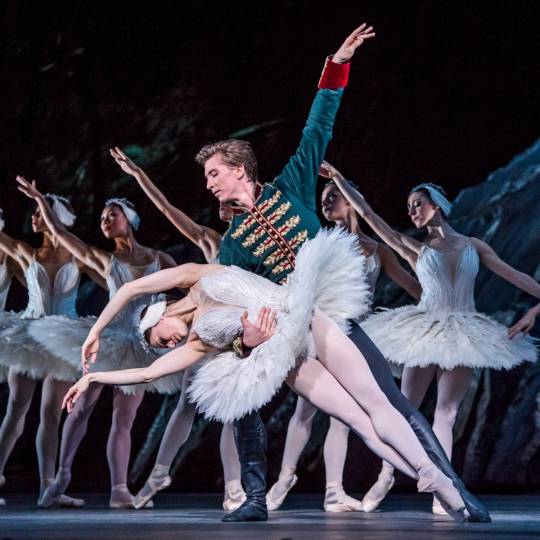
This photo from Swan Lake shows the ballerina at the mercy of her partner's strength, completely trusting (or hopeless?), draping herself over his arm. While the choreography for this ballet is very challenging and requires tremendous strength and control, the character of Odette- the swan queen- dances a series of movements intentionally designed to make her appear fragile, sad, desperate and submissive. The prince is captivated by her soulfulness and peculiarity and pursues her. She dances for her freedom, waiting to break the evil spell that transformed her from human to bird. This can only be done by a prince professing his true love and commitment. He is under her spell, but maintains the upper hand but controlling her fate. Spoiler: it doesn't work out. Another tragic ending.
Lumen. n.d. "Neoclassicism and Romanticism." Boundless Art History. https://courses.lumenlearning.com/boundless-arthistory/chapter/neoclassicism-and-romanticism/.
Mann, Cheryl. 2007. Victoria Jaiani and Temur Suluashvili in "Giselle" . Joffrey Ballet, Chicago.
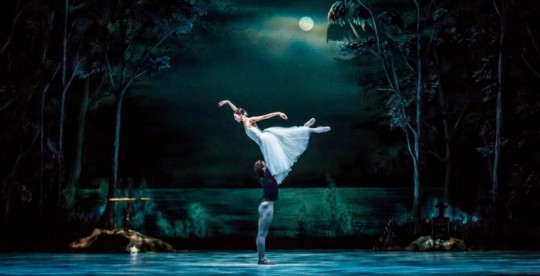
Act II of Giselle in the graveyard; the realm of the Wilis. Here the prince has been condemned to death by dancing, as ordered by the Queen of the Wilis. The former lovers dance in a tragic pas de deux. Similar to Swan Lake, the ballerina playing Giselle has been choreographed to essentially look dead. Her movements are simultaneously rigid and limp, signifying her departure from human life and her ability to float and dematerialize at any moment. Her heartbreak places her at the whim of her partner's desire to manipulate her body in an attempt to repossess her. Yet she remains relatively cold, trapped in her memory of her sadness. Another photographic example of the romantic ballerina living and dying for her man, and then transcending her earthly body to become an unattainable fantasy of unrequited love.
Mohin, Andrea. 2018. David Hallberg and Polina Semionova in American Ballet Theater's Swan Lake. The New York Times, New York.
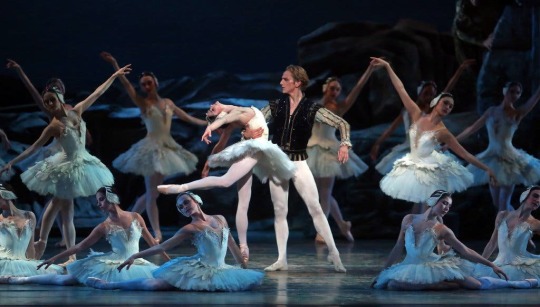
More evidence of recurring themes in fantasy and female submission.
Pazcoguin, Georgina. 2021. Swan Dive: The Making of a Rogue Ballerina. New York: Henry Holt and Co.
I selected this autobiography by New York City Ballet soloist Georgina Pazcoguin because she very boldly details her problems with sexual harassment, forced cosmetic surgeries, and racist policies within the ballet company. This demonstrates that the Romantic Era of ballet has reproduced its ideology and imagery so many times over 200+ years that it has become normative. While such behavior has never been okay, it certainly stands out as much more unacceptable and outdated by 2021 standards. Yet the ballet world remains isolated from much social and cultural progress past the early twentieth century. The legacy of the objectified and exoticized ballerina subjects Pazcoguin to male company members' entitlement to her body, touching her inappropriately as a "joke" whenever she enters the studio. As an already petite woman, she is harassed for being overweight and forced to undergo a $10,000 liposuction procedure so she can fit the romantic image of a delicate woman walking the line between life and death. Also standard to the Eurocentric origins of ballet is an inherent favoring of pale, white ballerinas. Pazcoguin was the first Asian American to become a soloist in her company, but was still relegated to the B cast for most productions.
Pennefather, Alice. 2021. Reece Clarke as Albrecht and Natalia Osipova as Giselle in Giselle. The Royal Ballet, London.

Even though he lied to her, betrayed her, and caused her untimely death, here we have Giselle attempting to save her prince from the Wili Queen's ruling of his death. Even in her heroic act, the man is still seen as being the strong one holding up her body, limp from romantic devastation.
Plisetskaya, Maya. c. 1976. "Swan Lake: Odette." Original Unknown. Pride of the Soviet People.
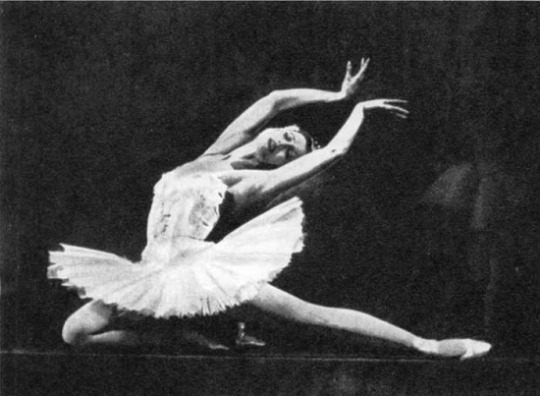
Photograph of famous Soviet ballerina Maya Plisetskaya as Odette the Swan Queen. Here we see another example of the standard broken, bird-like shape that makes up the Swan Lake choreographic signature. Odette is mourning her conditions, fearing that there is no hope for her. She is quite dramatically giving up as she sits by the water, periodically gazing at her own reflection. The unattainable ballerina is tortured by her own unattainable desire for salvation.
Scholl, Tim. 1994. From Petipa to Balanchine. London: Routledge.
I selected this book because its section on the Romantic Ballet Era breaks down the standard structure in plot development, particularly as favored by French choreographer Marius Petipa, whose original choreography is still danced in revivals of romantic ballets today. Scholl indicated three main components: a mad scene, a vision scene, a reconciliation scene wherein the protagonist and her love interest reunite. The rise in feminization of ballet coinciding with romantic themes underscores the collective association with women and intense emotional states.
Wollstonecraft, Mary. 1792. A Vindication of the Rights of Woman. London: Walter Scott Publishing.
It was important for me to find women's commentary on the social positioning of women in Europe at the time of the Romantic Era. Mary Wollstonecraft's feminist commentary validated many of the problematic tropes in the romantic ballets, supporting that the ballerina's qualities were not developed in an original artistic bubble. In A Vindication of the Rights of Woman, Wollstonecraft voices the injustice of women being denied access to full expressions of their intellect, with men being "ever placed between her and reason". She goes on to say that women are forced to view life through a limited lens, and required to "take things on trust". In each of the three ballets I've used as primary examples for this research, the ballerina protagonist was written to play characters that were dramatic, emotional, at times irrational, and completely physically trusting of her partner. In each production, there was a narrative shift that transitioned from realistic story to surrealism, which can be symbolically perceived as the separation between reason and irrationality/escapism-- the writer, director and choreographer, typically being male, standing between the ballerina and her ability to portray an autonomous, complex human.
Yusupov, Damir. 2019. Olga Smirnova as Giselle and Artemy Belyakov as Albrecht in Alexei Ratmansky’s reconstructed “Giselle” at the Bolshoi Ballet. Bolshoi Theatre, Moscow.

Image of the frail, Romantic ballerina in a wispy pose, portraying the ghost of a heartbroken peasant girl. Standing in an imposing arabesque above her is her former fiancé, who has journeyed to the graveyard to seek reconciliation. She is sad, crumbling and distant, giving the impression that she could float away at any moment to escape. Her partner sees this as a challenge and a chase, following her in an effort to interrupt her space and repossess her attention. Seemingly washing over the reality that the prince is the reason why Giselle is now dead and locked in tragedy, the audience is influenced to believe that this pursuit is romantic, rather than the bold display of entitlement that it is.
[1] (Lumen n.d.)
[2] (Scholl 1994)
[3] (Garafola 1997)
#ballet#romanticera#romanticballet#misogyny#misogynyattheballet sexisminballet objectificationofwomen
3 notes
·
View notes
Photo

I'm so incredibly excited to show this! This is the first picture took by @leledigitalartist in collaboration with @pinacotecalbertina and @accademia.to, featuring my latest 1830s dress. The dress is probably my best creation so far (I spent entire weeks in fittings) and it definitely needed a proper photoshoot. I'm so grateful we were allowed to shoot inside using also the antique furniture. My mittens are also antique. More to come! #victorianfashion #victorianera #costuming #costumemaker #historicalcostumedesign #reenactor #costumedesigner #maryshelley #1830s #1830sfashion #romanticera #earlyvictorian #ilfiorenero #historicalcostuming #historicalsewing #pinacotecaalbertina #accademiaalbertina (presso Accademia Albertina) https://www.instagram.com/p/CN5Pd3aggD-/?utm_medium=tumblr
#victorianfashion#victorianera#costuming#costumemaker#historicalcostumedesign#reenactor#costumedesigner#maryshelley#1830s#1830sfashion#romanticera#earlyvictorian#ilfiorenero#historicalcostuming#historicalsewing#pinacotecaalbertina#accademiaalbertina
3 notes
·
View notes
Text
Robert Schumann Concerto In A Minor Op 54 For Piano And Orchestra (1951)
Publication date 1951 DINU LIPATTI, Piano, PHILHARMONIC- SYMPHONY ORCHESTRA OF NEW YORK with HERBERT VON KARAJAN conducting Robert Schumann's Concerto in A Minor, Op. 54 for Piano and Orchestra is a significant work in the Romantic piano concerto repertoire. Composed in 1845, this concerto showcases Schumann's profound understanding of piano virtuosity and orchestral color, making it a beloved piece for both performers and audiences alike. During the early 19th century, the Romantic era brought forth a surge of creativity and artistic expression. Robert Schumann, a leading figure in the Romantic movement, composed the Concerto in A Minor at a time when the piano concerto genre was evolving. This period saw a shift from the classical style of Mozart and Beethoven to a more emotionally charged and technically demanding approach to composition. The concerto consists of three movements: 1. Allegro affettuoso – The opening movement introduces the main thematic material, featuring a lyrical and expressive dialogue between the piano and the orchestra. Schumann's innovative use of thematic development and virtuosic piano passages sets the tone for the entire concerto. 2. Intermezzo: Andantino grazioso – This second movement serves as a contrasting interlude, providing a moment of respite from the intensity of the first movement. The piano takes center stage with a graceful and introspective melody, accompanied by delicate orchestral textures. 3. Allegro vivace – The final movement bursts forth with energy and exuberance, showcasing the technical prowess of the soloist and the orchestral brilliance. Schumann's mastery of thematic transformation and dramatic orchestral writing reaches its peak in this exhilarating conclusion. Schumann's Concerto in A Minor is characterized by its seamless integration of piano and orchestral elements. The piano part is demanding yet lyrical, requiring both technical agility and expressive depth from the soloist. The orchestral writing is rich and colorful, providing a dynamic backdrop for the soloist's intricate melodies and passages. Furthermore, the concerto demonstrates Schumann's use of cyclic form, where thematic material reappears and undergoes transformation throughout the work, creating a sense of unity and coherence across the three movements. This structural innovation contributes to the concerto's profound emotional impact and compositional ingenuity. In conclusion, Robert Schumann's Concerto in A Minor, Op. 54 for Piano and Orchestra stands as a testament to the artistic innovation and emotional depth of the Romantic era. Its intricate blend of piano virtuosity, orchestral grandeur, and thematic unity makes it a timeless masterpiece that continues to captivate performers and audiences worldwide. As we delve into the intricate layers of this concerto, we gain a deeper appreciation for Schumann's unparalleled musical genius and the enduring power of his compositions.
#RobertSchumann#ConcertoInAMinorOp54#PianoAndOrchestra#ClassicalMusic#RomanticEra#GermanComposers#OrchestralWorks#MusicalComposition#MusicAnalysis#PianoConcertos#MusicAppreciation
0 notes
Text
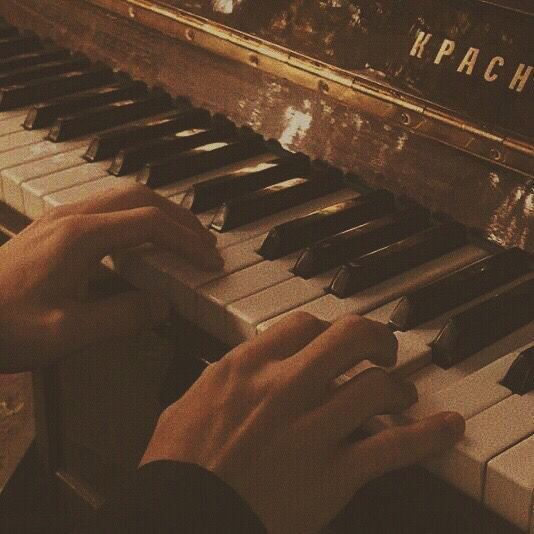




#piano#music#sheetmusic#instruments#thepiano#musicalinstruments#musical#baroque#renaissance#romanticera#classical#classicalmusic#culture#cultures#cultured#theatre#concert#classicalconcert#musicaesthetic
4 notes
·
View notes
Text
1 note
·
View note
Video
🎶🎹Still working on "Etude no. 4 in C# minor" by Chopin --- 🎶🎹 * * #piano #practicing #chopin #etude #chopinetude #music #classical #romanticera #classicalmusic https://www.instagram.com/p/CAD3vQEnC0b/?igshid=waqyahup63j2
1 note
·
View note